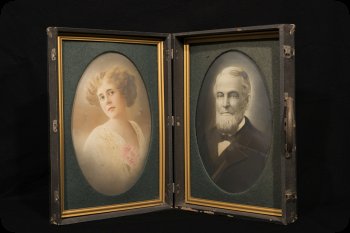Salesman’s Sample Case
This sample case was carried by a representative of one of the many late 19th and early 20th century commercial portrait companies that created large crayon portraits from customers’ photographs. Armed with this case, the salesmen traveled (usually by train) across the country, knocking on doors, displaying his products, and deflecting objections in an effort to secure orders. The householder who decided to place an order gave the salesman the picture he or she wished to be enlarged, which the salesman then delivered to the corporate headquarters. There, artists enlarged existing photographs with a device called a solar camera and colored them in by hand. The portrait was delivered several weeks later. These commercial portrait companies’ mass production and sales techniques helped transform portraiture, paradoxically perhaps the most personal of art forms, into a mass-produced and mass-marketed product for the 20th century.
In the late 19th century, improving transportation networks coupled with the development of mass manufacturing firms gave rise to the birth of modern salesmanship. Manufacturing firms hired armies of salesmen to create demand for their products and create brand loyalty. These salesmen helped to transform America from a society of producers to a society of consumers.





